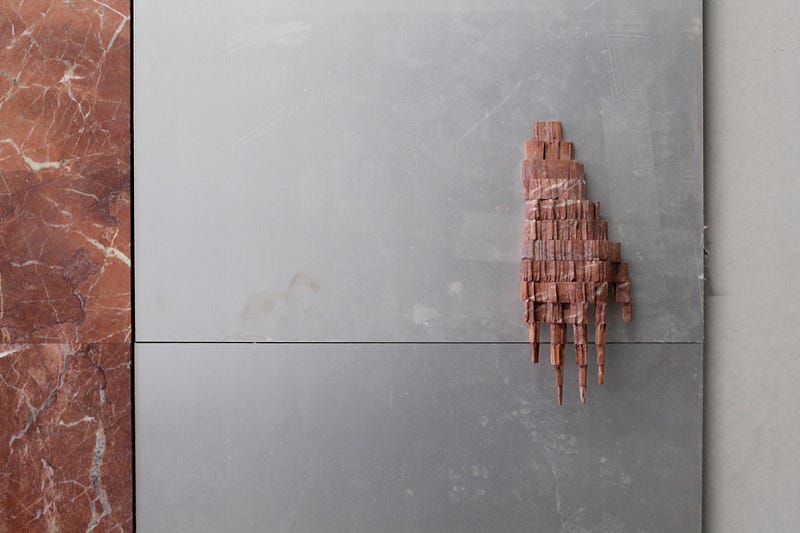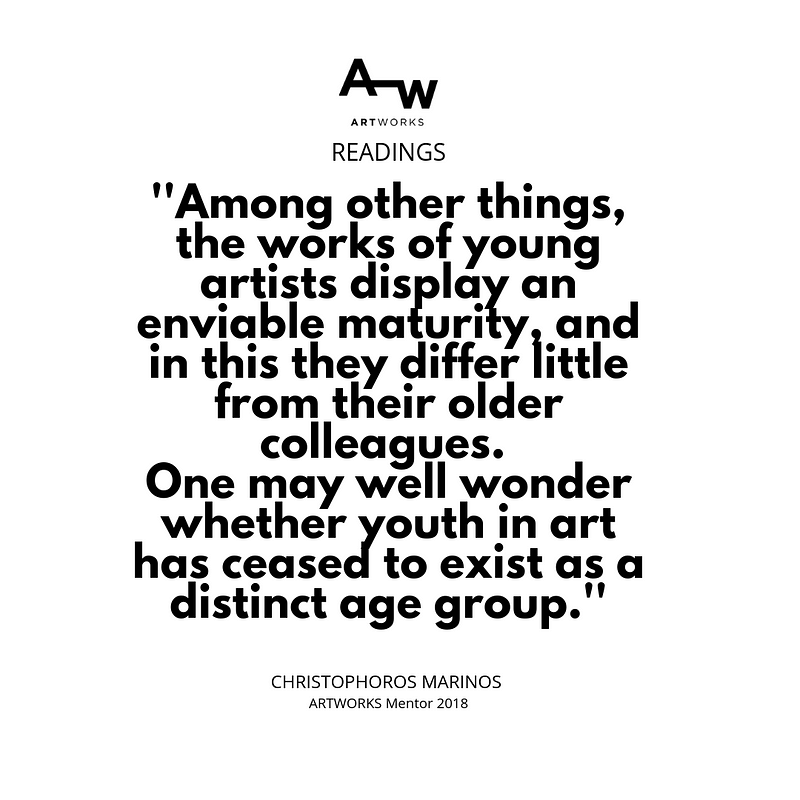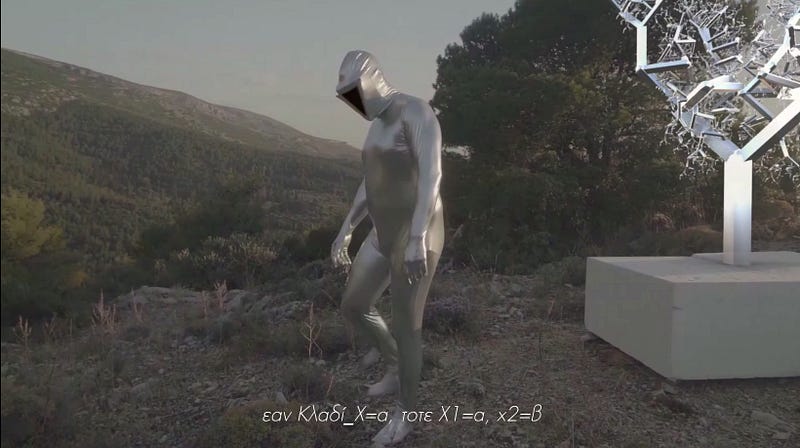03.09.2019
Υoung Greek artists: a timeless paradigm
Visual arts

Let me go straight into the heart of the matter — the focusing on young artists as the motive power of change, on youth’s innate ability to reshape radically the artistic landscape — through an example from the past: a little-known artistic event which can function as a prism, or, better still, as a snow globe. Let’s shake the globe and travel magically across time to 1963 Athens. Don’t be fooled by the snowflakes — the setting is bustling Patission Street in midsummer. In a room at the School of Fine Arts of Athens, AICA Hellas organises the group exhibition Young Greek Artists. We have no pictures of the works on show, but we do have the triptych brochure. It contains the artists’ names, the titles of their works and a brief text by the “curators” (in quotes: the term was not established at that time) which sets out the following rationale:
Alongside the visits to places and works of art from ancient and Byzantine Greece, we meant to give the opportunity to our colleagues from the International Art Critics’ Association to form an idea about the artistic production of an utterly contemporary Greece. Thus we have gathered here a brief yet representative panorama of the current work by young Greek painters and sculptors from all movements. Aside from the participants’ age limit — up to 45 years — our choice was based on the vibrancy of works executed as recently as possible, on the promises they show or those they have already fulfilled. Some of the exhibitors we invited are already known to our colleagues, others not yet. Some others were invited but could not, for various reasons, submit recent work. There are certainly more out there who await to be discovered; there are also some who have to convince us of the import of their current work. This exhibition represents a selection, and all selections involve some arbitrariness. Here we tried to keep it to the minimum, giving space to every work that betrayed a glimmer of creativity. Our colleagues, upon viewing these works, will tell us to what extent we have succeeded. We do not know the impressions of the foreign art critics whom the exhibition meant to inform and entertain.
However, the names of those young Greek artists — twenty painters and eight sculptors — show a remarkable prescience. Apart from four or five who are known today only to those well-versed in contemporary Greek art, most of those artists were to play a leading role in the country’s art life.3 Seen from today’s viewpoint, with the hindsight of the participants’ subsequent course and contribution, describing the show as merely successful would be an understatement: we could say that it turned — at least on a symbolic level — a new leaf for the visual arts in post-war Greece. Incidentally, one year earlier Thomas Kuhn had coined the term “paradigm shift” to define the transition from a scientific model in crisis to a booming new one.4 In this sense, this 1963 exhibition certainly constituted a new “prospective paradigm”.
As a reference and starting point, this exhibition paradigm as it is expressed in the organisers’ rationale can be useful in evaluating similar ventures, in this instance ARTWORKS5 that supports and promotes the work of young Greek artists. Moreover, thinking dialectically, we are called upon to identify the similarities and differences in the art, the mentality and the skills between the youths of 1963 and those of today, who are beginning — or ending prematurely — a promising creative course. It is true that young Greek artists represented and still represent, despite the losses from the scourge of brain drain, the “utterly contemporary Greece”. It is also true that all young artists who live in Greece face constant competition from the so-called “glorious past” or “tradition” or “ancient Greek and Byzantine legacy”, against which they are measured — not to mention “a sun that ain’t kidding” which one needs to take seriously into account. It is often said that Greece has some noteworthy contemporary art, but the statement has never been axiomatic: establishing the fact in the public’s conscience requires a consistent visionary drive — ideally, a strong set of concurrent activities organised or supported by private or public organisations, collectors, curators, art critics, gallerists, publishers as well as the artists themselves. Today, to be sure, the restrictive division into “painters and sculptors” is obsolete. Young Greek artists now express themselves through a broad range of media (painting, sculpture, drawing, installations, collage, performance/live art, video, photography, text, new media art) used in parallel or combined (in the “post-medium condition” so to speak), but this is not to say that there aren’t still some champions of purity — artists devoted exclusively to a single medium or genre. As in 1963, several young Greek artists are active abroad, having already exhibited at major galleries, independent art spaces, biennials and prestigious institutions. The difference is that today’s youths are multi-skilled. Take for example the 45 visual artists supported by ARTWORKS in its first Programme: almost all of them can write very well (statements on their work as well as texts on theory), sometimes equally well or even better than many young art historians and critics. Almost all hold a postgraduate degree, some continue to PhD level, and more than a few work also as curators, having studied the subject; also, many are knowledgeable in web design and self-publishing. It becomes evident that young Greek artists are now fully in tune with their foreign colleagues in terms of interests and skills. Apart from the diametrically opposed social conditions which are crystallised in the progress/decline dipole, there is also a radically different mentality among today’s young artists.

The years of wandering (Wanderjahre) as part of young artists’ training and a prerequisite for their aesthetic cultivation have long ceased to be a priority. The journey to Italy, highly popular in Dürer’s time but also a sine qua non for many artists who emerged in the 1950s and 1960s,8 has given way to browsing around the Internet. Indeed, in many cases the traits and traces of such an experience make up the subject matter of the work of young artists. In 2010, on the occasion of the first solo exhibition of Petros Moris, I had noted the importance of these virtual travels in his work: “Navigating this changeable, prolific and highly scattered atlas of the internet — not unlike the ‘atlas of the impossible’ which Michel Foucault attempted to unfold in his groundbreaking essay The Order of Things — the artist uses diverse aspects of human activity to describe a new, dematerialised materialism”. Indeed, no one disputes the fact that the traditional ways of acquiring knowledge — travelling, libraries, museums, the external reality — have been largely replaced by this vast, constantly renewed encyclopaedia with the endless reserves of stored memory: the Web. In the case of KERNEL, a group comprising Theodoros Giannakis, Peggy Zali (ARTWORKS Fellow 2018) and Petros Moris (ARTWORKS Fellow 2018), the theory and the experience of Internet culture constitute a major field of interest and engagement. As they note, “We approach the Internet as a model ‘space’ where the phenomena of cultural and political action that concern us are crystallised and presented for exploration in a cohesive way. So although our work is not predominantly about the Ιnternet as a medium or the tradition of ‘Ιnternet art’, it often employs Ιnternet tools and is considerably shaped by the new consciousness proposed by the age of networks”.

In 2010, KERNEL curated the exhibition Full/Operational/Toolbox, in which they explored the idea of “the artwork as a hybrid object, as a flow of multiple manifestations and possibilities”. The exhibition included the project Index of Potential, an Internet library the group had set up earlier that year. In order to bring this collaborative library from the digital to the real world, KERNEL erected Dexiontype shelves to store printouts and borrowed books which had been previously uploaded on the website of the project. Standing out on one shelf was the English edition (Penguin Classics) of Gustave Flaubert’s Bouvard et Pécuchet (together with the Dictionnaire des idées reçues). In some peculiar way the subject of the exhibition, which promoted the “idea of an alternative economy of creativity”, was reflected in the contents of this ‘crazy book’ as well as in the special processing of the author’s style, which stands out for “a maniacal obsession with transitions and with the repetition of words”, as Roland Barthes observes.
Bouvard et Pécuchet undoubtedly foreshadows many of the obsessive interests of today’s artists. It is no accident that in the personal statements in which the 45 young artists supported by ARTWORKS comment on their work we find words like “obsession”, “mania”, “excess”, nor that most of them perceive art as “constant probing”. As they state themselves, their key interests include “the appropriation of existing archive material”, “interdisciplinary approaches”, “conveying a timeless reality”, “combining seemingly unconnected themes”, “public space as a field of research and exploration”, “the concept of physicality”, “the materiality of the media”, “appropriation of space”, “forms of fakeness“, “the endless process of acquiring knowledge and information”, “the introduction of pseudo-scientific processes in an artistic context”. All this explains how the art of young artists, Greek or otherwise, has the gift of sorting and amalgamating (Marcel Schwob), strives for hermetism (Stéphane Mallarmé) and values the poetics of Pataphysics (Alfred Jarry). Among other things, the works of young artists display an enviable maturity, and in this they differ little from their older colleagues. One may well wonder whether youth in art has ceased to exist as a distinct age group.
Let us come back to the present in a somewhat cinematically violent way: the snow globe falls off the old narrator’s hands and shatters; the snowflakes fall in a shapeless white mass, another type of landscape. Most of the young Greek artists in the 1963 exhibition are no longer around. Nevertheless, their “promise” and their “vibrant works” (indubitably such by the innocent criteria of a bygone age) bore fruit, leaving a weighty legacy for subsequent generations. Are these 45 talented artists to have a similarly brilliant trajectory? Will their work and actions leave their mark on the art life of this country? Chances are the secret of success lies in the element of deviance. I recall an interesting thought by Marc Augé: “It is those [artists] who innovate and possibly surprise or baffle, who, in retrospect, will fully emerge in their time. We need the past and the future to be contemporary”. In his latest book the eminent anthropologist, now at an advanced age and contemplating the approaching end, takes it one step further with this aphorism: Old age does not exist. […] Time is a palimpsest. […] we all die young.
Christopher Marinos, art historian, curator and ARTWORKS Mentor 2018, regularly contributes articles to the greek and international press. He has edited a large number of publications on contemporary Greek art, including Possibilities: Interviews with Young Greek Artists (futura, 2006), The Work of Curating (AICA Hellas, 2011), Maria Karavela (AICA Hellas, 2015) and Vlassis Caniaris (Cultural Foundation of Tinos, 2016). In 2008, he founded the online art journal kaput, while in 2013 he was part of the curatorial team of the 4th Athens Biennale AGORA and chief editor of the two accompanying publications (Guidebook and Anthology). From 2012 to 2015, he was the president of the Hellenic Section of the International Association of Art Critics — AICA Hellas. In 2013, he formed part of the curatorial team of the 4th Athens Biennale AGORA and chief editor of the two accompanying publications (Guidebook and Anthology).



